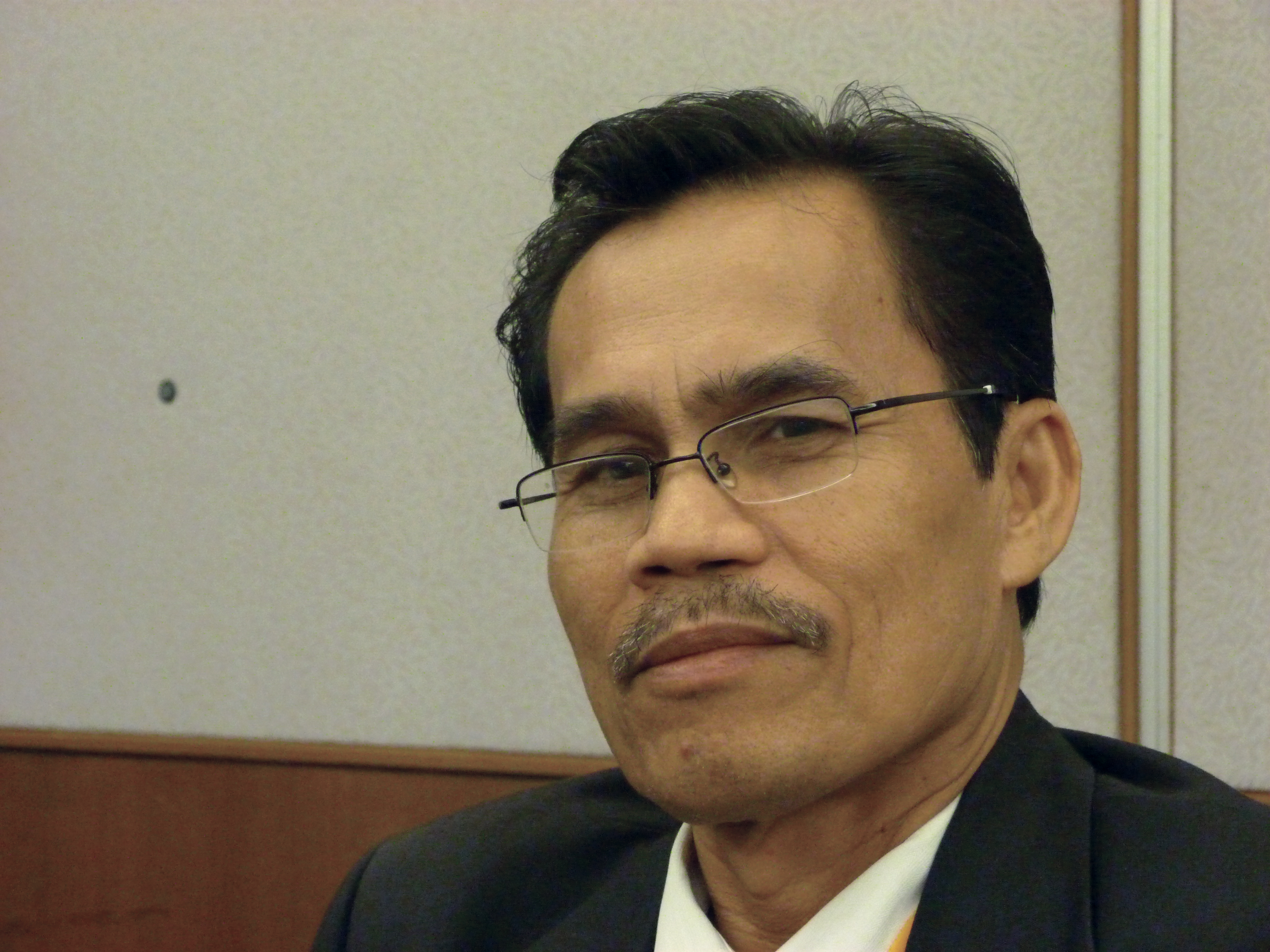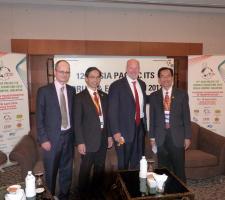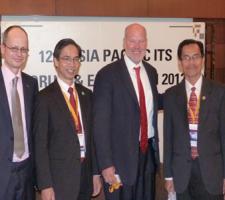
“We need the government to decide and take the lead so that the industry can follow” Mohammad B. Husin, president of ITS Malaysia
Taking advantage of the attendance of the heads of ITS Asia-Pacific, ITS America, Ertico – ITS Europe, and ITS Malaysia as the host nation of the recent 12th ITS Asia-Pacific Forum in Kuala Lumpur in April, ITS International initiated a round table discussion on the big ITS issues confronting the individual regions. For such a diverse collection of advanced and emerging nations spanning the globe, in terms of the advancement of ITS, a common single issue emerges above all others
Rightly so, industry magazines like ITS International feature a range of issues confronting, or inhibiting the development of this industry. These include key factors such as common standards, international cooperation, interoperability, the ever-present issue of safety – which becomes even more pressing as the inhabitants of developing nations take to the roads in greater and greater numbers – and the attendant issues of congestion, the environment and transport-related emissions.Sitting above all of that, the elephant in the room as it were, is the need for politicians and policymakers to recognise that this industry already has many of the tried and proven solutions to some of society’s most pressing present and future problems – if only they would properly grasp them.
As Hermann Meyer, CEO of
It’s a view shared by
More broadly, Asia-Pacific is the fastest growing region as an industrial powerhouse of the world, developing, manufacturing, and exporting quality goods to people all over the world. But as Hajime Amano, secretary general,
In the US, the federal government has failed to provide a new transport funding bill for two years now. Nine short term extensions have only created a level of uncertainty for state and local transport planners. According to Scott Belcher, president and CEO of
All of these views from across the globe underline the inescapable conclusion that, probably with the exception of in-vehicle systems developed by the automotive industry without reference to politicians, no matter what systems and solutions this industry comes up with, in the majority of cases, they are effectively still-born without political champions and drivers of change among decision-makers. For that reason, these leaders of ITS associations, and also the dozens of others in national associations around the world, are to be applauded for what they have already achieved for this industry and for their unstinting efforts, often in the face of institutional inaction or apathy, to promote the answers to the most pressing, and daily worsening, mobility issues facing the world.
James Foster, News Editor,
ITS International
Hajime Amano, secretary general, ITS Asia-Pacific and president of ITS Japan, started his career as a robotics engineer at
“After working on transportation systems for over 20 years, I have come to realise that ITS is a far more challenging arena because it involves so many unknown parameters,” he says.
“We don’t even have the means to constantly observe the behaviour of the system in question. We don’t know exactly how many cars are on the street. We don’t know how each one of those vehicles is running. And most of all, transportation systems involve unpredictable human behaviours and policy issues.”
As Amano points out, Asia-Pacific is the fastest growing region and an industrial powerhouse of the world. Competence in the manufacturing sector heavily depends on efficient transport of materials, products and the people working for it. Problems in transport, including insufficient capacity for the growing demand, safety, efficiency in terms of time and energy, and reliability will only get worse without strong action from policymakers.
Similar problems
“If we look at urban transportation, we have a number of mega-cities in this region such as Beijing, Tokyo, and Bangkok, where millions of people are commuting every morning and evening” he says. “Therefore, we also share similar problems in transportation - insufficient capacity for the growing demand, safety, efficiency in terms of time and energy, and reliability. Simply constructing new roads and railways for higher capacity is no longer feasible. We also have to devise efficient use of limited infrastructure through both technologies and social innovations,” Amano says, and expresses the belief that ITS has much higher potential than any conventional fields of technology to overcome the challenges we are facing now.Summarising the challenges facing the Asia-Pacific region, Amano lists these as excessive concentration of population and businesses to mega-cities; heavy dependence on automobiles and a lack of public transportation network; a high ratio of motorcycle related fatality and injury; insufficient data collection for scientific analyses and countermeasures; a lack of trust in new technologies; and a departure from human operator centred culture.
“The solution to those challenges is a coordinated combination of measures,” Amano says. “We need a grand design of multi-modal transportation networks, and an awareness of the behavioural changes by citizens and industries. Alongside that, we need the active application of ITS technologies to implement those measures efficiently in terms of effectiveness, cost, and speed. But most importantly, we need strategic policy decisions for their implementation.”
Malaysia
For ITS Malaysia, the kind of centrally driven policy commitment that the ITS world is crying out for, has been realised with the formation of SPAD which has been given the task, the powers, and the funding mechanisms, to totally transform public transport in the country into a world-beating holistic multi-modal system.However, for Malaysia’s already well-developed road sector, the situation is more similar to most countries around the world where policy and decision makers are in various sectors of government. As Mohammad B. Husin, president of ITS Malaysia says, top of the association’s wish is a government champion who will take ownership of the industry and drive it forward to synergise what is already in place, such as traffic management systems, tolling, VMS, navigation systems, etc.
“We have a solid electronic toll collection system, but we need to move forward on issues such as interoperability and take it to the next stage which would be an open road tolling (ORT) system. We need the government to decide and take
the lead so that the industry can follow,” he says. Although only established five years ago as an offshoot from the Road Engineering Association of Malaysia, the association has grown to 500 members, and has gained significant institutional respect. “Since we set up ITS Malaysia, and particularly more recently, the government has been asking us for our views on certain things that they are doing. And that is good because they are recognising us and our role and the expertise that we have in ITS Malaysia,” Husin says, adding that the organisation’s role in co-hosting the 12th Asia-Pacific Forum has provided it with a major boost and increased profile that can be built on.
America
Whether or not the US Congress manages to achieve what it has failed to do for the past two years and enact a new multi-year transportation funding bill, is in the lap of the politicians. There is a small window of opportunity over the next few weeks, but if that is missed, then it will be next year, with more short term extensions to the five-year SAFETEA-LU (Safe, Accountable, Flexible, Efficient Transportation Equity Act: A Legacy for Users) bill which expired on 30 September, 2009.As Scott Belcher, CEO of ITS America points out, the current situation creates a level of uncertainty for state and local transport planners. “It’s difficult for them to enter into long-term contracts. It’s difficult to get bonding and it’s difficult to basically do the kind of work that they need to do. And because of this we are going to miss another major construction cycle. This lack of certainty is combined with shrinking capital budgets based on real dollars declining and states having to make cuts in a variety of different ways,” he says.
Performance-based
But when multi-year funding does come, things will be different in an important way for the ITS industry because the new legislation will bring with it a more performance-based transportation system. Both the House and Senate draft bills have extensive performance-based elements built into them.“We’ve had the bi-partisan policy commission which has a whole study based on performance-based transport systems,” says Belcher. “And then you’re starting to see regional, state and local governments deploying performance-based systems on their own to measure their own performance and to be held accountable to their voters.
“The reason that is important is it will reward those transportation organisations that are in fact performing well against objective criteria and it will incentivise those jurisdictions that aren’t investing well, or intelligently, in their transportation systems. And that will be important for the ITS industry because any performance-based system would be based on objective data that would have to be collected and measurements would be made against those base lines. That all requires that you collect data and use it in intelligent ways, which is what smart technology is all about,” he says.
Another big issue facing the transportation in the US is the limitations that state and local administrations have to introduce tolling and their ability to enter into public private partnerships (PPPs).
Alternative ways of funding
“As we face the financial shortfalls that we are facing, be it because we don’t have long term legislation or because we are underfunding our system, both of which are true, the alternative is to come up with alternative ways of funding,” Belcher says. “We’re not willing to raise the gas tax for political reasons, and we are not willing to entertain, in a real way, a mileage based user fee, for political reasons.“So the next logical tool in the arsenal for raising capital is tolling. And, in the US there is a prohibition against tolling the interstate highway system. What that does is force states to work around that by adding new capacity that they can then toll. So, you can add new capacity to the interstate by creating high occupancy/toll lanes (HOT lanes). However, to do that requires a lot of money that states don’t have. So they have to be able and willing to enter into wide scale PPPs,” Belcher says, conceding that the US is still struggling to find a good PPP model. “I think there is capital waiting but we just haven’t found the right model,” he says.
Europe
In terms of the policy and institutional support to ITS development and deployment, Europe fares very well as a direct consequence of the European Commission which is acting as an extremely active driver. For mega infrastructure projects and the development of multi-modal transport systems, one only has to first consider the TEN-T (Trans European Network-Transport) programme and what has been achieved over the last few years and planned for the next decade. And then consider the likelihood of even a fraction of that being achieved, left to individual governments to act cohesively!In terms of the deployment of ITS technologies, here again the EC is a powerful trans-national driver and Ertico – ITS Europe is an active partner in many key initiatives. Its CEO Hermann Meyer points to the EU-wide in-vehicle emergency call system (eCall), ITS for Urban Mobility and multi-modal journey planners examples.
Focus and development
“We started work on eCall in around 2003, and there was a lot of focus and development around standardisation so that the system would work across national borders. And now we are coordinating a project together with nine member states where the system is being tested in the different countries, and the EC has taken a decision to mandate its deployment by 2015.”Meyer provides another insight into the European situation concerning the deployment of ITS in the urban setting.
“Three years ago Ertico made a statement to the EC where we said we believed that the biggest challenges exist in the cities for mobility like congestion, accidents and emissions. Ertico pointed out that there is the biggest potential for ITS to improve the situation and to make mobility in cities more intelligent, smarter, and safer and also greener,” he says.
Many activities
Just three years later, there are many activities by the European Union on this issue. One of them is the Urban Freight Energy Efficiency Pilot (There are other examples that Meyer can point to which include activities in promoting multi-modal journey planners, working towards ITS as an enabler for electric vehicles and the integration of smart vehicles with a smart grid, and an initiative where cities are discussing, in Forums with Ertico and its partners, what their challenges are and where they believe it could be useful to have ITS applications solve some of these challenges.
“We had a Forum meeting on 1 Dec 2011 which was extremely successful,” Meyer says. “We got positive feedback from the cities and we have now started a cooperation with
While all of the above points to a positive situation in Europe in terms of ITS deployment, Meyer is not complacent. He stresses that over the last 20 years, and even up to quite recently, Ertico’s focus was largely related to R&D and developing certain services and technologies. Now the focus is shifting more and more to deployment and working towards encouraging policy makers to exploit them.
As host of this year’s
“But this time, we are also aiming for a declaration to be signed by the participating ministers giving the current and future world congresses a more formal role for policymakers to meet and to look at the current situation concerning ITS, and with regard to deployment,” Meyer says. “We’re also looking to them to give the industry some tasks where they say this is something we would like to see you develop further so that we can use it for the fulfilment of our policy goals.”








